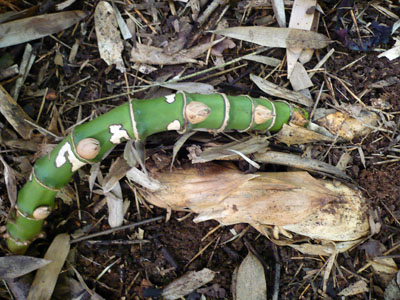Controlling the Spread of Invasive Bamboos
How to Grow Bamboo - Article Contents
Rhizome Barrier Installation Method
![]() Become a fan of complete bamboo on Facebook!!
Become a fan of complete bamboo on Facebook!!
Become a fan on facebook and ask us questions about bamboo control. You will get a bamboo expert answer within a couple of days!
Determine the Containment Area – The first step in rhizome barrier installation is to determine the size of the area that is to be contained. The more space the bamboo has, the larger it will be able to grow. As a general rule of thumb, the containment area for any species of bamboo should be no smaller than 1 square yard; however larger species will require more room to grow successfully.

Invasive Bamboo Rhizome of Phyllostachys atrovaginata.
Purchase the Barrier – The most common rhizome barrier in today’s world is High Density Polyethylene (HDPE). Barriers can be purchased through many online bamboo suppliers and at specialty nurseries. Barriers come in a variety of sizes and thicknesses. For sufficient containment, the barrier you purchase should be not smaller than 24” deep and 40 mil in thickness. This size may need to be increased for larger varieties of bamboo.
Remove any Existing Rhizomes – If you are trying to contain an established grove of bamboo it will be necessary to remove any existing rhizomes in the area. This is much easier said than done. You may be required to dig up the area surrounding the containment zone. Rhizomes have the ability to grow up to 20 feet in any direction in a single year.
Dig the Trench – A trench will need to be dug around the entire perimeter of the containment area. Be sure to keep the topsoil separate from the subsoil while digging. The size of your trench should be about 2 inches shallower than the size for the barrier. For example, if you are installing a 24” barrier, the depth of your trench should be 22” deep. The HDPE material should protrude above the surface to ensure that rhizomes do not make their way over the topsoil. The width of the trench only needs to be wide enough for the barrier to be inserted properly. It is also recommended to compact the soil at the bottom of the trench to make prevent the deepest reaching rhizomes from escaping the area.
Insert the Barrier – The barrier should be angled outward at the top of the trench. This outward angle will cause rhizomes to travel in an upwards direction after hitting the barrier. The goal of this angle is to prevent rhizomes from traveling underneath the HDPE material.
Seal the Barrier Method 1 - The ends of the barrier should overlap by no more than 3” and no less than 2”. Too much of an overlap and the rhizomes will travel between the seam, and too little of an overlap makes the barrier susceptible to gaps. Uses stainless steel strips or clamps to secure the ends together. The stainless steel strips should be the same length as the depth of the trench. Secure the strips at the bottom the trench and keep the top of the strip slightly below ground. It’s never good to have metal objects sticking out of the ground in your garden.
Seal the Barrier Method 2 – Another way to seal the rhizome barrier is to use double sided tape. This method requires that the overlap on the HDPE panels is at least 3 feet. Using this method is generally easier, but will require you to purchase more HDPE to compensate for the greater overlap. Once the barrier is in position, place a strip of double sided tape vertically along the overlapping area. We recommend that a piece of tape is used every six inches to create a sufficient seal.
Fill the Trench – The final step of installation for your bamboo barrier is to fill the trench. Start by filling the gaps with the subsoil and compacting it as tightly as possible in the process. Once the subsoil is depleted, finish it off with the topsoil. The topsoil can be compacted less tightly. The idea is to have the rhizomes attracted to the upper section of the barrier where they are less likely to escape. Be sure to maintain the outward angle of the barrier whiling filling the trench.
Routine Maintenance – Check the bamboo barrier every year of so to make sure no rhizomes have been escaping. If you find that rhizomes are breaching your barrier it may be necessary to patch up holes that have been created over time. It is also very important to keep the bamboo within the barrier well fertilized and watered. A bamboo is growing in less than adequate conditions will focus its energy on spreading rhizomes greater distances in search of more fertile conditions.
